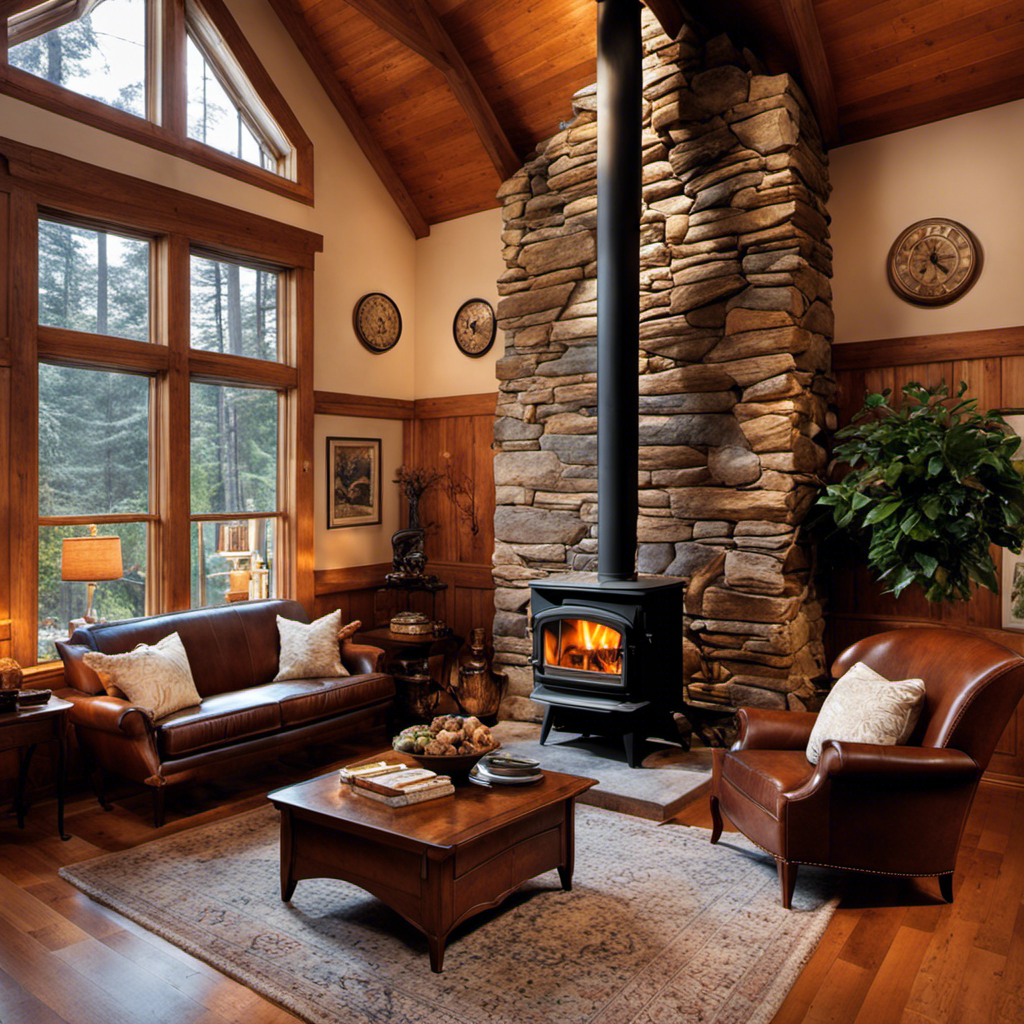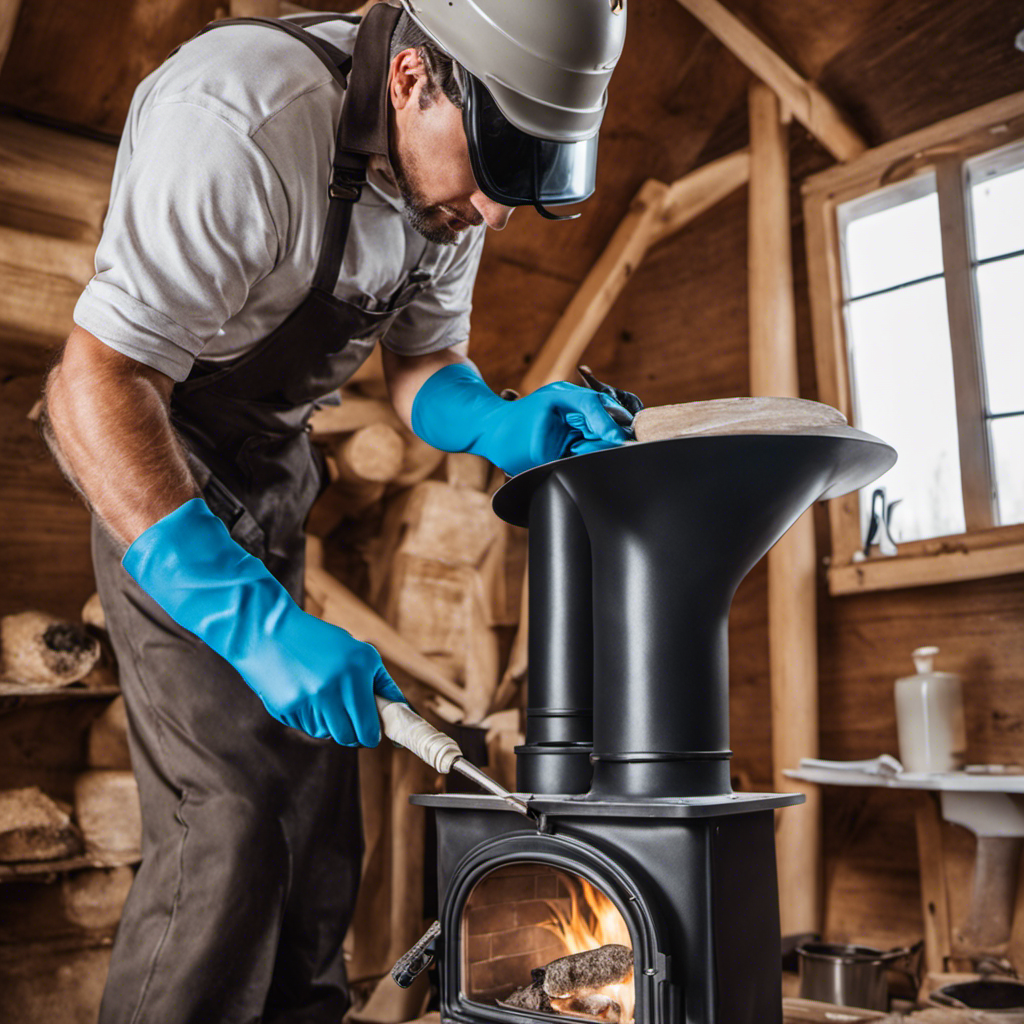Have you ever pondered the real efficiency of a wood stove? Allow me to illuminate this topic for you.
Wood stoves have long been a popular choice for heating homes, but their efficiency can vary greatly. In this article, we’ll dive into the factors that determine a wood stove’s efficiency, explore different designs, compare fuel types, and provide practical tips to maximize efficiency.
Get ready to discover the real-life examples and data-driven evidence that will help you make the most informed decision for your heating needs.
Key Takeaways
- Insulation plays a crucial role in preventing heat loss and maximizing heat transfer to the room.
- Well-designed stoves with proper insulation deliver more heat to the room and reduce heat loss.
- Wood stoves with adjustable air vents and dampers maximize efficiency and reduce wood consumption.
- Regular maintenance, including cleaning, inspecting and replacing door gaskets, is important for optimal wood stove performance and efficiency.
Efficiency Factors to Consider
In my experience, one of the key factors to consider when evaluating the efficiency of a wood stove is its insulation. Insulation plays a crucial role in preventing heat loss and maximizing the amount of heat transferred to the room.
When measuring efficiency, it’s important to consider the factors that affect it. These factors include the design of the stove, the quality of the materials used, and the combustion process. A well-designed stove with proper insulation can achieve higher efficiency by ensuring that more heat is delivered to the room rather than being lost through the stove and chimney.
Additionally, factors such as air supply and combustion control also influence the efficiency of a wood stove by optimizing the burning process and reducing emissions.
Understanding Wood Stove Design
I find it fascinating to understand the different designs of wood stoves. Wood stove maintenance is essential for optimal performance and efficiency.
Here are three key design elements to consider:
-
Combustion System: The combustion system plays a crucial role in how efficiently a wood stove burns fuel. Modern wood stoves often feature a secondary combustion system that helps achieve a more complete burn, reducing emissions and increasing heat output.
-
Airflow Control: Proper airflow control allows for better regulation of the burn rate and heat output. Wood stoves with adjustable air vents and dampers enable users to fine-tune the combustion process, maximizing efficiency and reducing wood consumption.
-
Heat Exchange System: Efficient wood stoves often incorporate a heat exchange system. This system captures and transfers heat from the stove to the surrounding area, increasing the overall heating efficiency and ensuring a more comfortable living space.
Understanding the design elements of wood stoves is crucial for proper wood stove maintenance and reaping the benefits of wood stove heating.
Comparing Fuel Types: Which Is Most Efficient
When comparing fuel types for heating, it’s important to consider which option provides the highest level of energy efficiency. To make an informed decision, we need to analyze the comparison of energy output and environmental impact of different fuel types.
To illustrate this, let’s examine a table comparing three common fuel types: natural gas, wood, and oil.
| Fuel Type | Energy Output (BTU) | Environmental Impact |
|---|---|---|
| Natural Gas | 1,000,000 | Low |
| Wood | 800,000 | Moderate |
| Oil | 1,200,000 | High |
Based on this data, we can see that oil provides the highest energy output, followed by natural gas and then wood. However, it is important to note that wood has a moderate environmental impact, while oil has the highest impact. Natural gas, on the other hand, has the lowest environmental impact.
Tips for Maximizing Wood Stove Efficiency
To get the most out of my wood stove, I regularly clean the chimney and ensure proper airflow. These practices are essential for maximizing wood stove efficiency. Here are three tips to achieve optimal performance:
-
Firewood Selection: Choose well-seasoned hardwoods like oak, maple, or ash. These woods have a higher energy content and burn more efficiently, producing more heat and less smoke.
-
Proper Wood Stove Maintenance: Regularly clean the stove, removing ash buildup and ensuring the air vents are clear. This allows for better combustion and heat transfer. Inspect the door gaskets and replace if necessary to maintain a tight seal, preventing air leaks and improving efficiency.
-
Efficient Burning Techniques: Use smaller, well-split pieces of wood to promote better airflow and more complete combustion. Avoid overloading the stove with wood, as it can restrict airflow and reduce efficiency. Use the damper to control the burn rate and maintain a steady, efficient fire.
Real-Life Examples of Wood Stove Efficiency
In my experience, using smaller, well-seasoned hardwoods like oak or maple has proven to be more effective in producing heat and reducing smoke.
When it comes to measuring the efficiency of a wood stove, scientific methods are employed. One common method is the heat output test, which measures the amount of heat produced by the stove. This test provides valuable data that can be used to compare different stove models and determine their efficiency.
Another important aspect to consider is the environmental impact of wood stoves, particularly in terms of emissions and air quality. Studies have shown that newer, EPA-certified stoves significantly reduce emissions compared to older models.
Frequently Asked Questions
How Long Does It Take for a Wood Stove to Reach Its Maximum Efficiency?
It typically takes a wood stove about 30 minutes to reach its maximum efficiency. Factors such as proper wood stove maintenance and fuel quality play a crucial role in achieving optimal efficiency.
Are There Any Safety Precautions I Should Take When Using a Wood Stove?
When using a wood stove, it is important to follow safety precautions. Common mistakes include leaving the stove unattended or using improper fuel. These precautions can prevent accidents and ensure the safe operation of the stove.
Can I Use Any Type of Wood in a Wood Stove, or Are Certain Types More Efficient?
Using a wood stove efficiently requires considering the type of wood used. Hardwoods like oak and maple burn longer and produce more heat compared to softwoods like pine. Moisture content also affects efficiency.
What Is the Average Lifespan of a Wood Stove?
The average lifespan of a wood stove depends on several factors. These include the quality of materials used, maintenance practices, and frequency of use. It is recommended to consult the manufacturer’s guidelines for specific information.
How Does the Size of a Wood Stove Affect Its Efficiency?
When it comes to wood stove efficiency, the size of the stove plays a significant role. Larger stoves have more surface area to transfer heat, resulting in higher efficiency.
Conclusion
In conclusion, wood stoves can be highly efficient when designed and operated correctly. Factors such as stove design, fuel type, and proper maintenance all contribute to maximizing efficiency. By following tips and guidelines, users can significantly increase the performance of their wood stoves.
Real-life examples have shown that with the right techniques, wood stove efficiency can be greatly improved. So, for those looking for a cost-effective and environmentally-friendly heating option, investing in a well-designed wood stove is definitely worth considering.
Growing up surrounded by the vast beauty of nature, Sierra was always drawn to the call of the wild. While others sought the comfort of the familiar, she ventured out, embracing the unpredictable and finding stories in the heartbeat of nature.
At the epicenter of every remarkable venture lies a dynamic team—a fusion of diverse talents, visions, and passions. The essence of Best Small Wood Stoves is crafted and refined by such a trio: Sierra, Logan, and Terra. Their collective expertise has transformed the platform into a leading authority on small wood stoves, radiating warmth and knowledge in equal measure.











